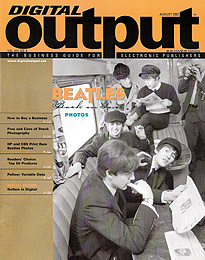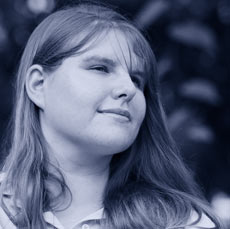|
  Aug. 2002—In February 1964 The Beatles arrived in the United States hard on the heels of the band’s first two hit singles, "I Wanna Hold Your Hand" and "I Saw Her Standing There." There was near pandemonium at every public appearance on the Beatles’ itinerary. The term "Beatlemania" was born when flocks of adoring fans, most of them girls and young women, were consumed by screaming bouts of celebrity hysteria. Aug. 2002—In February 1964 The Beatles arrived in the United States hard on the heels of the band’s first two hit singles, "I Wanna Hold Your Hand" and "I Saw Her Standing There." There was near pandemonium at every public appearance on the Beatles’ itinerary. The term "Beatlemania" was born when flocks of adoring fans, most of them girls and young women, were consumed by screaming bouts of celebrity hysteria.
It was a time when millions of American kids were scooping up records by the Mop Tops, as they were nicknamed by the press at the time, and the radio waves were dominated by songs like, "All My Loving," "Do You Want to Know A Secret," "Love Me Do," "Baby It’s You" and "Twist And Shout."
The Beatles were about to change American pop music and popular culture. Savvy press photographers were on hand to record every moment of that first U.S. tour, which included appearances on "The Ed Sullivan Show" – by far the most popular TV show of its time.
The CBS television network had a number of its publicity photographers on hand throughout the trip, and those shooters took hundreds of photographs, capturing the Fab Four at play and at work,giving the public a glimpse into the the pop stars' flashy, exciting lives. After a few images were culled to be printed in newspapers and magazines at the time, the majority were filed away and forgotten for almost 40 years. Now, the CBS Photo Archive is making some of those "lost" photos available to the public in a traveling museum exhibit built around large-format prints of many of the images.
Lost and Found
Titled "The Beatles: Backstage and Behind the Scenes," the exhibit debuted in Alberta, Canada and is now on display at the Radisson Deauville Resort in Miami, where it will run through September 2 (visit www.artvisionintl.com/ BeatlesExhibition.html for more information.) The Radisson’s Ballroom is home to the stage where the Beatles first appeared on a live broadcast of "The Ed Sullivan Show." Future stops for the exhibit include Tokyo, Japan and Seoul, South Korea. The final home for the exhibit, once it has finished its world tour, has not yet been determined.
"I thought [the pictures] were pretty fantastic," said John Filo, Director of Photography at the CBS Archive. "We all age and here they are, their first appearance in the U.S. It’s sort of a historical moment, and the pictures are just fun to look at; they are just very enjoyable. They are actually having fun and on tour. They weren’t ultra-established yet, I mean they where certainly a hit…and they were all together."
When Filo decided to make the collection available to the public, he turned to Hewlett-Packard to help make it a reality. The exhibit comprises 71 images from the black-and-white photos taken by CBS staff shooters at rehearsals for The Beatles’ appearance on "The Ed Sullivan Show" and some taken by photographer Bill Eppridge, who traveled with the group during the historic first tour of the States.
"Our stuff is done from dress rehearsals and rehearsals from the Sullivan show, whereas Bill actually rode with the Beatles from New York to Washington during a snowstorm," said Filo. "They were supposed to fly but instead they took a train. They are just amazing pictures that are just in line for the show, especially fans. Our stuff is more backstage, behind the scenes, so the two sort of complement each other and give you a nice, true picture of [the Beatles’] first and second appearances."
Technical Challenge
To create the prints, the film negatives first had to be scanned and repaired before being burned onto a CD. CBS took the film to Laumont Labs in New York City for the initial scans. "What we asked for was a really flat scan, we wanted as much information as possible, we didn’t want to lose anything in the highlights or shadows. They have tremendous retouching facilities and we just asked for repair of pinholes and scratches, all sorts of abuse these negatives received in the last 40 years," said Filo.
Nathan Moroney, who is senior color researcher for color imaging and printing technologies at HP labs, then took over, processing the digital images in Adobe Photoshop for color corrections and adjustments. Around half of the images needed only minor work adjusting color and the black and white points, Moroney said. Another quarter needed a little more time and work adjusting the color balances and repairing the remaining glitches. About 10 of the final images required more extensive work to repair damage and get the shadows and highlights perfected.
"The challenge was that there were quite a few difficult compositions," said Moroney. "You have something where you might have Ed Sullivan and the Beatles looking into a bank of photographers with stage lighting directly on their faces. In general, you’re going to have something where Ed Sullivan’s face is just a little over exposed – you’re looking a little bit blown out and highlighted. You can almost think of it as digital dodging and burning. That’s the kind of thing we did to the images, not necessarily to clean up any inherent defects but to try to equalize some of the properties."
To check for consistency and quality, a series of 4x6-inch thumbnails were printed and sent to CBS to be marked up and earmarked for more corrections. Filo then flew out to HP Labs at Palo Alto and spent several labor-intensive days fine-tuning the images and adding final touches. Filo, who’s background is in photography, said, "In essence, I went out and sort of became my own darkroom; did my dodging, burning, highlighting, shadowing, bringing out information in that photo that we really wanted to make it a great print." From there, new CDs were created with the retouched images, insuring that even if a hurricane or other natural disaster blows through Miami, new prints can be created and ready to show in a matter of days.
Finally it was time to actually create the prints. An HP Designjet 5000ps large-format printer was used. The Designjet is capable of running pigment or dye inksets; dye inks were used to create the Beatles prints.
It is a six-ink printer running CMYK, plus light cyan and light magenta. HP Photo Imaging Satin media was chosen and the prints were printed at 50x40 inches. The final files were about 20MB each, with a scanned resolution of around 2,400ppi (pixels per inch) and a print resolution of around 600dpi (dots per inch). "In terms of qualitative things I usually use the hair test. If you have a really nice 4x5 negative and scan it in and print it out, if you can get a nice single hair on George Harrison’s forehead printed out, rendered without any jaggies and still have a smooth forehead behind it, then you probably have enough resolution in terms of the data and the output to do a lot of basic tasks," said Moroney.
According to Vickie Rehberg, the Exhibition Marketing Manager for the show, some of the prints are traditional fine-art style photographs, while the rest are large format. The larger prints were then dry mounted, while the smaller, 20x24-inch prints were put in black, traditional frames.
Overall, about 20 hours worth of work spread out over a one-month period went to the scanning and prepress work, an additional 20 hours over two days with Filo for the fine tuning, with the actual prints created over the course of two days. "Its very exiting to be able to take the images in a pretty intensive set of two day printing, just create them all one after the other, just spool them off during the day, while I did my other work," said Moroney.
Saving History
The CBS Photo Archive dates back to the original formation of the Columbia Broadcast System in the late 1920s and includes all of the corporate and entertainment photos taken over the years. The Beatles photos in this exhibit survived the general purge of excess materials in the ’60s and ’70s when employees realized the value of the prints and hid them throughout the company. More recently the collection was consolidated into one location and the process of cataloging and digitizing over 30 million negatives began. Today, while most have been cataloged, they have not been digitized.
"Through guile and luck it’s managed to survive. Trouble is it’s not in a true archive state, its not set up like a commercial stock house, or something like that, and we’re trying to do that," said Filo.
CBS is also making collectable prints available for purchase. They will range in price from $300-$800, not including framing or finishing. The money collected from the sales will be funneled back into the Archives.
"Actually this is sort of a rare opportunity that consumers can actually order a collectable print from the CBS Archive," said Rehberg. "It’s sort of a bridge to the consumer world for the network though a fine art exhibit. And we are promoting that all the images in the exhibit can be purchased."
CBS has also released a collection titled "America Though the CBS Eye" which includes 150 images recounting the history of the network. That will be at George Washington University in September. CBS also has plans to debut an Elvis exhibit in Mississippi in January, which will include rare photographs from his early years.
From the hits like "Yesterday," "A Hard Day’s Night," and "Hey Jude" to the current "Beatles 1" CD that topped the Billboard charts and broke all the records, the Beatles have entertained us and captured our attention. Their songs continue to inspire us, the silly rumors continue to amuse us (Paul is dead? What were they thinking?) and their lives continue to fascinate us. And now, thanks to the power of digital technology, we can once more return to a time of Mop Tops and tie-dye. "All You Need is Love."
|


